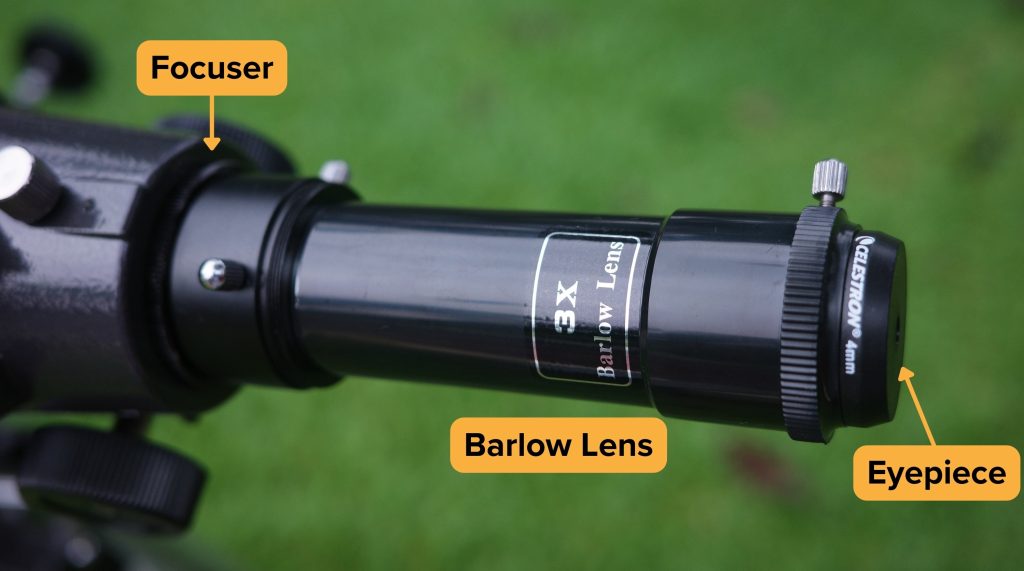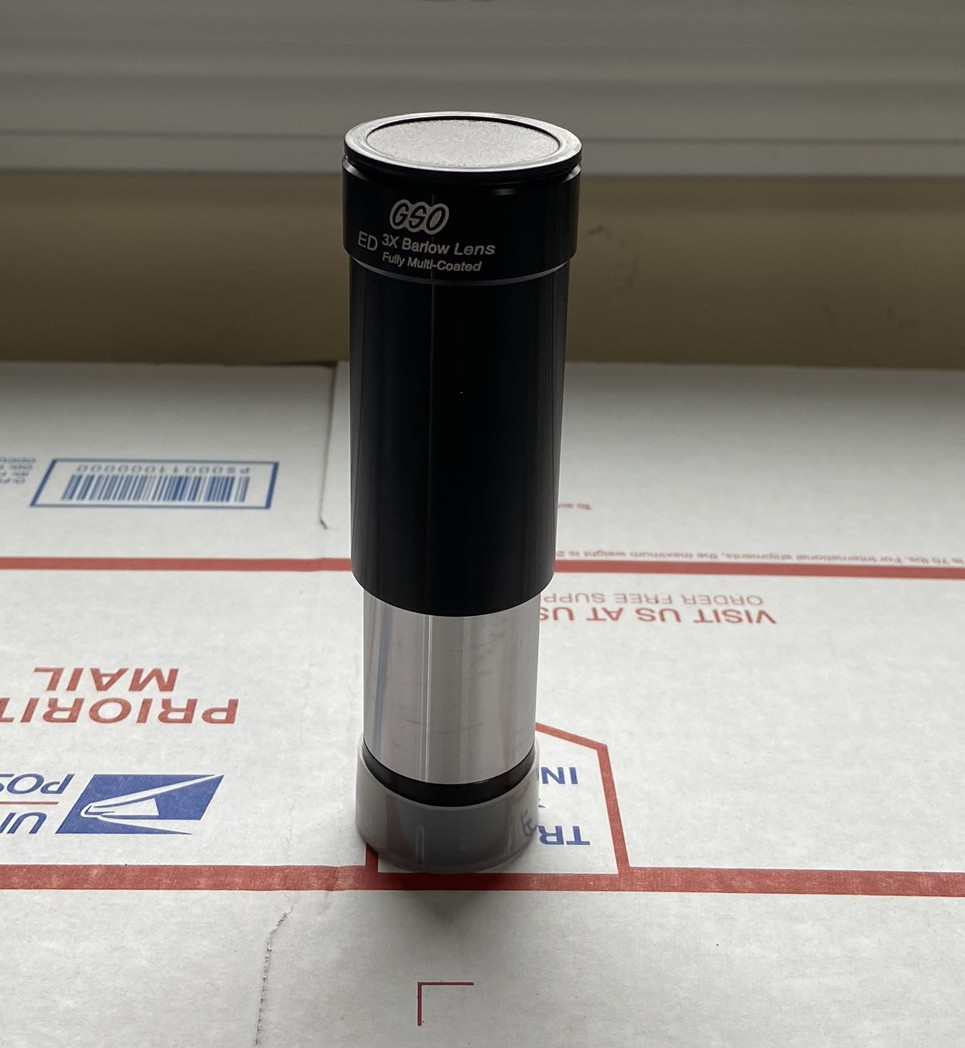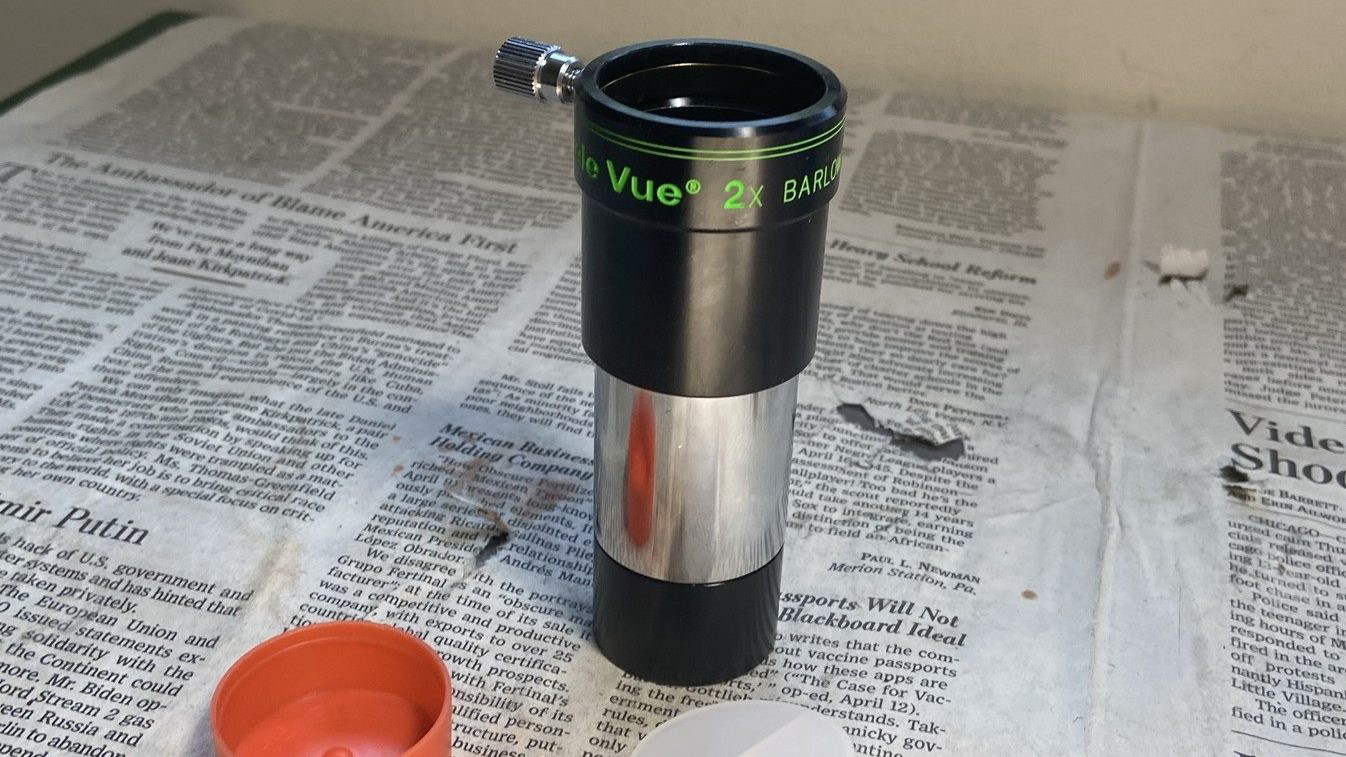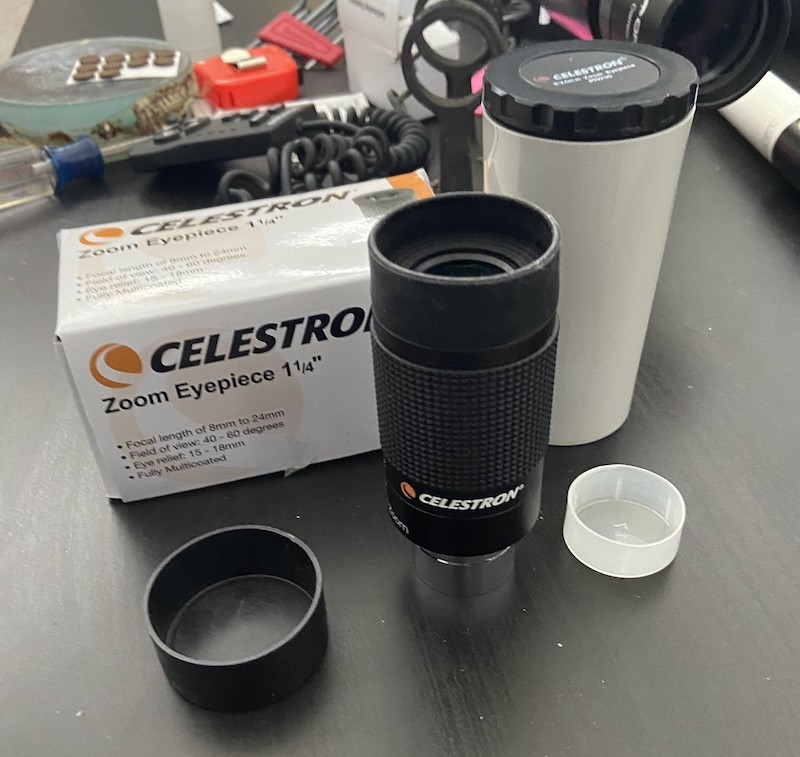
The Barlow I (and my colleague Zane Landers) primarily use is a GSO/Apertura 2.5x Apo Barlow. I chose it because it has good optics yet remains quite affordable. With any of my telescopes, this 2.5x Barlow multiplies the effective magnification of any eyepiece I use by 2.5 times.
For example, my 8″ Dobsonian has a 1200 mm focal length and normally gives me 48× magnification with a 25 mm Plössl. Add a 2.5x Barlow, and that reaches 120x. This is because the telescope’s focal length is effectively multiplied by 2.5 times to become 3000mm with the integration of the Barlow lens, which in turn increases the magnification I get at the eyepiece.

My Advices For Those Looking to Buy a Barlow
- What I normally do is avoid duplicating magnifications.
For example, many beginner telescopes come with 20mm and 10mm eyepieces. Getting a 2x Barlow will make your 20mm eyepiece provide the same magnification as the 10mm eyepiece, so in such cases, I’d rather get a 5mm eyepiece instead of the 2x Barlow.
A 3x Barlow, on the other hand, effectively converts the 20mm and 10mm eyepieces into 6.7mm and 3.3mm eyepieces, respectively. These are extremely short focal lengths, but they’re not redundant. So in total, I’d have 20mm, 10mm, 6.7mm, and 3.3mm focal lengths to choose from.
Likewise, in the case of my previously mentioned GSO 2.5X Barlow, I knew it would render the 25mm/10mm setup common in many beginner telescopes redundant.
- Don’t overpower your telescope with high magnification Barlows
It’s also important to remember that Barlows aren’t magic when it comes to magnification. Your telescope still has a maximum useful magnification defined by its aperture and optical quality. So don’t just get a 5x Barlow because it gives you the highest power.
- Consider your telescope’s focal ratio before deciding on the Barlow
If your telescope’s focal ratio is at f/10, f/15, or higher, I don’t think it makes much sense to raise the focal ratio even more, so you’ll probably only need a 2x Barlow if that.
However, a telescope at f/5 or less might actually be able to make use of even a 5x Barlow in some rare circumstances. Don’t even consider a 5x Barlow unless your telescope has an extremely low focal ratio.
Generally, the higher the Barlow’s magnification, the less versatile it becomes. High-magnification Barlows often don’t work well with short-focal-length eyepieces because the combination produces extremely high magnifications that can exceed the useful magnification limits of your telescope.
If I were you, I’d stick with magnifications of 2x to 3x. The most common power for a Barlow is 2x, but they can also be found in 2.5x, 3x, and even 5x varieties, and rarer, more esoteric magnifications can be found for certain specialty applications. (Binoviewers, for example).
- Be prepared to throw away the Barlow lens that you get while purchasing your telescope
If your telescope came with an included Barlow, odds are it’s very bad. I only use such Barlows to remind myself of their uselessness.
The most common type included with cheaper beginner telescopes is a single plastic lens, which, whenever I’ve used it, has caused severe chromatic aberration and other distortions in the eyepiece image. The dual-element Barlow lens has emerged as the popular choice in the industry.
For optimum results, a Barlow lens should integrate seamlessly without introducing any optical distortions or diminishing the field of view. I believe that the view through a 10mm eyepiece combined with a 2x Barlow should be almost identical to that of a 5mm eyepiece of the same design. If this isn’t the case, it indicates that the Barlow lens is of inferior quality or has design flaws.
- Don’t cheapen out, and get a Barlow with a 2+ lens element that is fully multi-coated
When I’m searching for a Barlow, I always choose one with an achromatic or apochromatic lens (2 lens elements or 3 or more lens elements). I also ensure that it is fully multi-coated to prevent internal reflections and preserve high contrast.
Unlike some others, I don’t consider Barlows to be an element to cheap out on, since a bad Barlow can make the image lose its sharpness and contrast. If it’s going to double your eyepiece collection anyway, I’m guessing you can afford to make sure you don’t end up with one that adds aberrations and false color fringing.
My 1.25″ Barlow Lens Recommendations
It’s likely that you are going to want a 1.25” Barlow over a 2” one. Most people have one or two 2″ eyepieces and the rest are 1.25″. For planetary imaging, 1.25″ short-focal-length eyepieces are all you need.
I have a 2″ 2X GSO Barlow that I like very much, but I don’t use it as much as I thought I would. When I didn’t have wide angle 1.25″ eyepieces, I used it for a while, but as I filled in my eyepiece set with 82 degree 1.25″ eyepieces, I stopped using the 2″ barlow. But, for a while, I used it a lot.
A 1.25” Barlow is also cheaper and much lighter in weight than a 2” unit.
For just $20, you may get a NEEWER’s 2x basic, no-frills Barlow
For under $40, you can get the GSO 1.5X/2X Shorty that I also have
GSO’s 2x Barlow is a two-lens element design that features full multi-coating, just the way I like.
This one also has a removable 1.5X barlow element, which effectively gives me two additional magnifications for each of my eyepieces.
GSO does offer a version of this Barlow with T-threads for a slightly higher price, should you need it. T-threads are used to directly attach a DSLR or mirrorless camera, though these are far from the best cameras for the planetary imaging for which a Barlow is suited.
For just over $50, get the GSO 2.5X that I mostly use
For just above $100, I’d recommend a Tele-Vue Barlow

When it comes to Barlows from premium brands like Explore Scientific and TeleVue, I don’t see a whole lot of difference between a mid-range barlow and a premium barlow. I think at the price point of $200 or more, you may want to consider a Focal Extender instead.
Recommendations for Barlowing 2″ Focuser/Eyepiece
A 2” Barlow is unnecessary for most users, as you’re more likely to use 1.25″ eyepieces for higher magnifications. If you’re using a 1.25″ eyepiece, you only need a 1.25″ Barlow to extend magnifications higher than your eyepieces allow. Likewise, for planetary imaging, any suitable camera sensor does not need a 2” Barlow; 1.25″ will suffice.
The exception may be those people who have very long focal length scopes, say over 3000 mm, who would like to leverage their 2″ eyepieces and their wide apparent field of views. 2″ eyepieces tend to be quite expensive so being able to Barlow them can be a very reasonable approach if your eyepiece budget is limited.
One of the scopes I use is a 14″ Meade LX200 with a 3500 mm focal length. I have two 2″ eyepieces. I could use my 2″ barlow with this one, but I still tend to go to my 1.25″ 82 degree eyepieces rather than barlow the 2″ eyepieces. Most people don’t Barlow 2″ eyepieces.
Also, combining a 2” Barlow lens with a 2” eyepiece often adds significant weight to telescope setups. This combination introduces balance issues in telescopes with cheap focusers, affecting the stability and orientation of the telescope. I’d warn you to always ensure that your telescope can comfortably support the combined weight of the Barlow lens and the eyepiece to avoid any mishaps.
I see a real bargain in GSO 2″ 2X ED for below $100
I’ve tried the Celestron Luminos 2.5x and got remarkably sharp images; my $150 2″ pick.
“Powermates” or “Focal Extenders” For Extreme Quality
TeleVue, a premium/luxury eyepiece manufacturer, sells both Barlow lenses and a series of accessories called “Powermates.” The generic term is “Focal Extender.” If you must have the highest-quality image to support your top-of-the line eyepieces, I believe this is the one to get.
Explore Scientific carries its own brand of Focal Extenders, which are highly comparable to TeleVue’s Powermates. These devices used to be priced lower than their Tele-Vue equivalent, but after COVID, I’ve noticed that the price difference is so thin that I would urge you to just get the higher-quality Powermate.
All of these are rather niche devices, and are only really important if you have long-focal-length, wide-field-of-view luxury eyepieces. For instance, my generic 32mm Plossl and my Explore Scientific 11mm 82-degree work fine with a 2.5x regular Barlow, but my Televue 16mm 82-degree Nagler seems to be wrecked by the Barlow.
The reason being that a simple true Barlow lens causes a few changes to the properties of eyepieces as a result of pushing the exit pupil outwards. For example, it can:
- Increase their eye relief
- Cause kidney-bean blackouts when you move your eye to look around
- Vignette the light path of certain long-focal-length eyepieces, providing a dimmer, narrower field of view.
- Certain Barlows may add small amounts of false color fringing
Focal Extenders use a more complicated optical system to remove all the effects of the extended eye relief in long-focal-length luxury eyepieces, allowing us to treat the telescope as if it were a regular telescope with a longer focal length.
Another crucial difference between Barlows and Focal Extenders is that the exact magnification factor of a Barlow will be slightly different depending on the spacing between the Barlow lens and the eyepiece or camera sensor. Focal extenders, however, always magnify exactly by the magnification factor, no matter the spacing between the camera sensor or eyepiece and the telescope optics.
Opinion: I Prefer Barlows Over Zoom Eyepieces
I’ve written a standalone article on Zoom Eyepieces, which, like the Barlow, is a scheme to use a single accessory to vastly increase the number of available magnifications. I’ll spare a brief thought for them here, too.
Zooms use a complicated optical mechanism to smoothly change the focal length of the Zoom eyepiece to access any magnification within a certain range. For example, a Celestron 8-24 Zoom eyepiece can change its focal length to any number between 8mm and 24mm to get an unlimited number of possible magnifications.

Zooms have several drawbacks compared to regular eyepieces: they often have narrower fields of view, they can be softer at the edges, and they can have mechanical problems.
I’d rather have a set of eyepieces and a good Barlow. Barlows generally do not degrade the quality of eyepieces, though I’ve noticed that some low-power luxury eyepieces can be affected. Zoom eyepieces, on the other hand, are often not as good as individual eyepieces.
Zoom eyepieces have a limited range, with the higher focal length being about 2x-3x the lower focal length, like in the case of Celestron’s 8mm to 24mm Zoom, and usually top out at mid-powers. For example, the Celestron 8-24mm Zoom eyepiece tops out at 8mm, a medium power focal length for many telescopes. If you already have a Zoom eyepiece, a Barlow can still be useful for low-focal-ratio telescopes to reach higher powers.
For example, a good kit for a f/5 travel telescope (could be a Short Tube 80 refractor, or perhaps a 5” or 6” f/5 Newtonian) might be a 32mm Plossl for wide field and low power, an 8-24mm Zoom eyepiece for mid powers, and a 3x Barlow to turn the 8-24 into a 2.7-8mm.

Is GSO 1.25″ 3x ED Barlow Lens good for a 70×400mm refractor telescope?
As is described in the article, you pick your Barlow according to your goals. What level of magnification are you trying to achieve and what eyepieces you have now. However, I have found that GSO makes good, moderate-priced barlows. I have two and like them very much.
With a 70 mm aperture, I would not look to push more than 140X with any expectation of a good image. Much of the time 100X will probably give you a better image with more detail. But don’t hold back on my say so. A Barlow is a great, inexpensive way to test those higher magnifications without having to buy eyepieces. Some nights the air will let you push much higher than you can normally.
Hi there. In the comments for your article on eyepieces you mention that you use a 2x Barlow with your BHZ eyepiece that has a removable element also making it a 1.5x. Is this the GSO Barlow mentioned in this article and if so, is it the 2″ or 1.25″ version? Many thanks.
The 2X Barlow I use with the Baader Hyperion Zoom is the 2″ GSO which has a removable 1.5X Barlow lens. I screw this onto the 1.25 to 2″ adapter that comes with the zoom which is treaded for filters. This works very well in my 8″ and 12″ Newtonian/Dobsonians as I would need an adapter for the BH Zoom in these focusers. However, GSO has the 1.25″ version that can be used directly on the zoom and would be most appropriate for a 1.25″ focuser scope. I have not used the 1.25″ GSO but have no doubt it would work well.
If you use this method in a diagonal, check to make sure that the added length of the Barlow element does not touch the mirror/prism in the diagonal. If it would touch you might have to pull back a bit and lock the zoom there. You can also buy parfocalizing rings that lock onto an eyepiece barrel to hold it out of the focuser a bit on a consistent basis. Just make sure that if you use the zoom without the Barlow element that you have enough into the diagonal to get a solid lock on the eyepiece. This is not a concern on a Newtonian as there is no diagonal.
Is it possible to attach barlow lens (Barlow optical only element, without extension tube) to the output side of an eyepiece, in order to increase the eye relief of the eyepiece?
I am thinking of this in an attempt to “convert” the regular binocular into the one with diagonal prism on the eyepiece side – in order to be able to see the image through the diagonal prism I need to extend the bbinocular eyepiece’ eye relief multiple times. Do you think it makes sense?